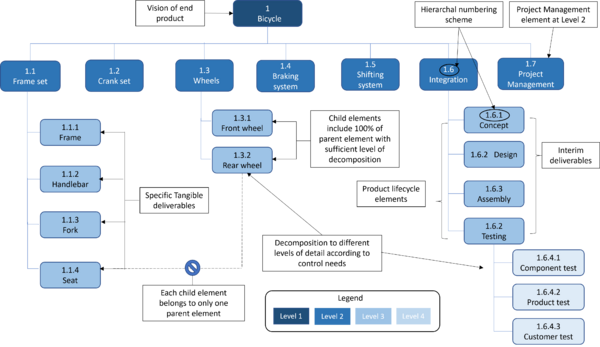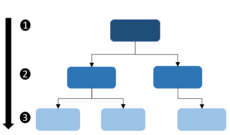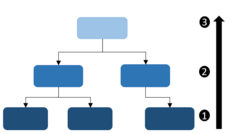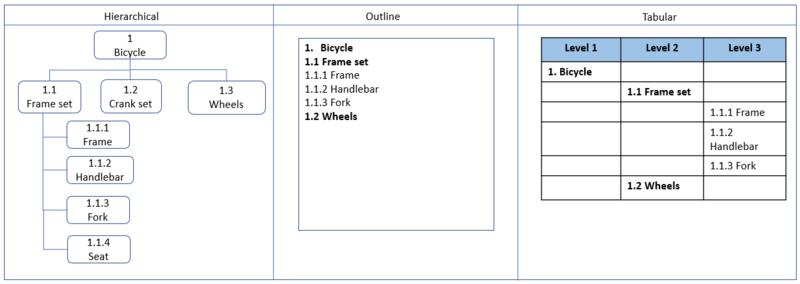Building Effective Work Breakdown Structures (WBS)
(→Introduction) |
(→How to decompose the project work?) |
||
| Line 167: | Line 167: | ||
=== Decomposing the project work === | === Decomposing the project work === | ||
==== How to decompose the project work? ==== | ==== How to decompose the project work? ==== | ||
| − | + | [[File:Decomposition technique diagram.png|500px|thumb|text-bottom|right|Figure 4: Decomposition technique diagram <ref name="Bucktik"> Bucktik, L.''"Secrets to Mastering the WBS in Real-World Projects: The Most Practical Approach to Work Breakdown Structures (WBS)! (2nd Ed.) PMI "'', 2010</ref>. ]] | |
| − | + | The decomposition technique is used when creating a WBS to break down the project. This is an iterative process that starts by identifying the best approach, according to section 3.2, to decompose the major deliverables. Figure 5 shows the iterative nature of the work decomposition until all the work packages are identified. When breaking down the scope of the project, you should consider the question: ''Is this work package detailed enough to be effectively estimated and managed, or should it be broken down further for better comprehension and management?'' <ref name="Bucktik"> Bucktik, L.''"Secrets to Mastering the WBS in Real-World Projects: The Most Practical Approach to Work Breakdown Structures (WBS)! (2nd Ed.) PMI "'', 2010</ref>. | |
==== When to stop decomposing the work? ==== | ==== When to stop decomposing the work? ==== | ||
Revision as of 15:34, 15 February 2023
"If you fail to plan, you are planning to fail" Benjamin Franklin
Regardless of the life cycle approach, successful project management requires a comprehensive and detailed plan [1]. A project manager’s main responsibilities include planning, integrating, and executing plans. Structured planning is essential given the relatively short duration and controlled resources of projects. Without proper planning, projects, and programs can face the following consequences [2]:
- No clear and defined requirements at the beginning of the project
- Setting unrealistic expectations
- Disorder and chaos
- Attempts to place blame
- Punishment
There are four main reasons for project planning: 1) To minimize or eradicate uncertainty, 2) To improve operational efficiency, 3) To gain a better understanding of the objectives, and 4) To establish the foundation for monitoring [2]. The first major step in the planning process after defining the project requirements is to develop the Work Breakdown Structure (WBS), it is the most important element because provides a common framework for [2]:
- Describing the total project described as a summation of decomposed elements
- Planning can be performed
- Determining costs and budgets
- Monitoring time, cost, and performance
- Establishing schedules
Given all the benefits of building an effective WBS, the purpose of this article is to serve as a guide for project managers in:
- Understanding the purpose and importance of creating a WBS.
- Identifying the key characteristics and components of a WBS.
- Implementing a delivered-oriented WBS effectively.
- Evaluating the quality and completeness of a WBS.
Developed by Luisa Fernanda Salazar Rivera s222401
Contents |
Introduction

To determine when the development of a WBS can start, it is necessary to have an idea of the typical phases involved when launching a project [2]. Figure 1 presents a standard project launch process:
The PMBOK Guide - Seventh Edition addresses the five elements related to scope:
- Scope: Scope encompasses all the deliverables required as part of a project. A deliverable is any unique product or work that should be produced to complete a process, phase, or project. [1] [2].
- Project Scope:Refers to the tasks that must be completed to achieve the defined scope of the project [1] [2].
- Scope Statement:Document that describes the objectives, deliverables, end result, and justification of the project. It addresses the questions: who, what, when, why, where, how, and how many. This document confirms that the scope of the project aligns with the Statement of Work (SOW) provided by the customer [1] [2].
- Scope Management Plan:Document that describes how the project scope will be defined, developed, monitored, controlled, and verified. [1] [2].
- Statement of Work (SOW):document that provides information related to the customer´s requirements and expectations for the project [1] [2].
Having an understanding of key elements related to scope will enhance the reader´s comprehension of the following sections focused on detailed planning.
Overview of the WBS
What is a WBS
A WBS, as defined in the PMBOK Guide - Seventh Edition, is “A deliverable-oriented hierarchical decomposition of the total scope of work to be carried out by the project team to accomplish the project objectives and create the required deliverables.” [1].
Core characteristics
Based on the definition of a WBS provided in section 2.1 the following characteristics should be highlighted:
- The deliverable orientation indicates the definition of specific outcomes of the project. [1].
- The hierarchical representation indicates that a WBS is organized into parent-child relationships. Each descending level represents an increasingly detailed definition of the work [1] [3].
- The decomposition nature indicates that a WBS translates the entire project scope into smaller components called work packages as will be further described in section 3.2 [1] [3].The 100% rule is related to this core characteristic of the WBS. This rule states that the WBS should contain 100% of the work defined in the project scope and include all the required deliverables that should be completed. This rule is applicable to all levels within the hierarchy in terms of having 100% of the activities defined at the “child” level to deliver the work presented by the “parent” level [1].
Purpose of creating a WBS
The purpose of having a WBS is to assist project managers and stakeholders to develop a clear vision of the project’s outcome. It provides a visual representation of all the deliverables across the project life cycle. Additionally, the WBS assists in the planning process by defining work packages that are more manageable pieces of work that can easily be scheduled cost estimated, monitored, controlled, and communicated[1].
Why is it essential
A well-defined WBS will aid in having a commonly accepted scope definition between all project functions and stakeholders. If this is not properly aligned, the chances of having inadequate and inaccurate project deliverables are high. Furthermore, these deliverables will prevent having a good understanding with stakeholders, and a good decision-making process, and will ultimately result in not achieving the project objectives. Therefore, it is essential to align expectations and have a common understanding of the project scope among all members and stakeholders [1] [4].
Types and components of a WBS
Styles to present a WBS
The way project managers present the WBS can vary according to the organization's needs and how the WBS will be used. There are three main representations as shown in Table 1. It should be noted that Table 1 only introduces the most common representation styles. However, it is not a comprehensive WBS [1] [5]:
- Hierarchical:This is the most common representation of a WBS. In this structure, each box connects the child to the parent element. The most common version places the project at the top level and explicitly displays the hierarchical decomposition into smaller elements [1] [5].
- Outline:In this style, the WBS is presented as a list. Each level displays an alphanumeric outline code or numbering scheme and the component[1] [5].
- Tabular:Another representation is the tabular style. The columns in the table represent the hierarchical structure and each row have an alphanumeric outline code or numbering scheme and the component as in the outline style [1] [5].
Types of decomposition for a WBS
There are several valid ways to structure a WBS and its decomposition in practice. Different sources identify different types of decompositions, such as deliverable-oriented, phase-oriented, and product-oriented, among others. When building a WBS it is common to use a combination of different types of decompositions [1] [5].Table 2 provides descriptions and examples to assist in practical implementation, although the WBS examples are not exhaustive.
| Type of decomposition | Description | Example |
|---|---|---|
| Deliverable-oriented | Any component that supports the delivery of the final product. |
1. Book
1.1 Outline
1.1.1 Conduct research
1.1.2 Develop an outline of the content
2.2 First draft
2.5 Editing
2.6 Printing and distribution |
| Phase-oriented | Organized based on project phases. Each phase represents a stage of the project life cycle |
1. Building
1.1 Project Preparation
1.1.1 Develop project plan
1.2 Site Preparation
1.3 Construction
1.4 Project completion |
| Product-oriented | Organized based on the components required to deliver a final product |
1. Bicycle
1.1 Frame set
1.1.1 Frame
1.2 Crankset
1.3 Wheels |
Main WBS components

The focus of this section is to explain the main WBS components. This example was taken from the Practice Standard for Work Breakdown Structures by the Project Management Institute (PMI). Figure 3 was selected for simplicity in illustrating the product, and the intention is to allow the reader to focus on the WBS and its essential components. [1]
The main components of a WBS will be explained using figure 1 as a reference:
- Levels and WBS IDS:
Level 1: Regardless of the type of decomposition or the style of the WBS, the first level always represents the name of the project, product, or initiative. This level includes the entire scope of work necessary to produce the product, service, or outcome of the project designated by the number 1. In figure 2, the “bicycle” represents the product of the project [1] [5].
Level 2: This is the first level of decomposition for the project which provides a high-level view of the scope of the project. The numbering in the second level is 1.1, 1.2, 1.3,…., 1,n. In the example of the bicycle, the second level represents all the components required to deliver the final product [1] [5].
Level 3 and below: These levels decompose further the deliverables from Level 2. These levels correspond to only one parent in level 2 and the numbering is: 1.1.1, 1.1.2, 1.1.3, …, 1.1.n, 1.2.1, 1.2.2, 1.2.3, …, 1.2.n, according to the needs of the project [1] [5].
- Work Packages:
As introduced in section 1.1, a work package is defined as the lowest level in a WBS which represent tasks that can be assigned to a team member or department. For project managers, this level of detail will allow to reliably estimate cost, duration, and to monitor and control the work [1] [5].
Building effective WBS
Preparation methods
There are different methods and tools available to create a WBS such as top-down and bottom-up development strategies, WBS organizational standards, WBS templates, brainstorming, expert assistance, and mind mapping, among others. The selected method depends on the project objectives, requirements, assumptions, and constraints [5]. This article will focus on explaining the top-down and bottom-up approaches as they are often referred to in the literature about WBS.
Top-down method
This is one of the most preferred methods when creating a WBS. The decomposition process starts at the top of the WBS. In other words, you begin with the overall picture and continue breaking down the work into smaller, more manageable components [5]. The following steps describe the general approach for developing a WBS following the top-down method:

Step 1: Identify all the final products, services, or outcomes that the project will deliver. They are the level 2 components [1] [5].
Step 2: Define major interim deliverables to accomplish each level 2 components [1] [5].
Step 3:Break down each major deliverable to a level of detail that allows appropriate management and control. Following the 100% rule, the total of elements at each level represents 100% of the necessary work for the above element [1] [5]. Section 4.2.1 will present a decomposition technique for the project work.
Step 4:Review and validate with key stakeholders until agreed that the project planning can be successfully completed and that the execution will produce the required deliverables and results [1] [5].
Bottom-up method
This method starts at the lowest level of deliverables – the work packages – and works upwards to the top level of the WBS [5]. The following steps describe the general approach for developing a WBS following the bottom method:

Step 1: Identify all the work packages of the project (deliverables), each work package typically contains one deliverable [1] [5].
Step 2:Group related work packages logically [1] [5].
Step 3:Aggregate deliverables to the next parent level. Following the 100% rule, the sum of elements at each level represents 100% of the work required below it [1] [5].
Step 4:Once a specific set of interconnected work packages has been consolidated into a parent element, re-examine the subset to make sure that all the work has been included [1] [5].
Step 5:Repeat until all the work packages have been aggregated to a single parent, level 1 element of the WBS, and make sure that the completed structure encompasses the entire scope. [1] [5].
Step 6:Review and validate with key stakeholders until agreed that the project planning can be successfully completed and that the execution will produce the required deliverables and results [1] [5].
Decomposing the project work
How to decompose the project work?

The decomposition technique is used when creating a WBS to break down the project. This is an iterative process that starts by identifying the best approach, according to section 3.2, to decompose the major deliverables. Figure 5 shows the iterative nature of the work decomposition until all the work packages are identified. When breaking down the scope of the project, you should consider the question: Is this work package detailed enough to be effectively estimated and managed, or should it be broken down further for better comprehension and management? [5].
When to stop decomposing the work?
Various guidelines for determining when to stop the decomposition process are based on the amount of time that takes to complete a work package [5]. An example of this rule is given by Dr. Harold Kerzner: "A typical work package may be 200–300 hours and approximately two weeks in duration"[2]. A practical tip given by Liliana Buchtik is to decompose to the level of detail for which you are able to manage, assign the work, and estimate cost and time [5].
WBS Dictionary
The WBS dictionary is a document that supports the WBS by providing comprehensive information for each element within it. The information in the WBS dictionary typically includes a detailed description of the work, deliverables, and milestones associated with each activity. The dictionary components can be used to drive scheduling, cost estimating, managing, and controlling work [1]. Figure 6 provides a description of each component in the WBS dictionary and an example based on figure 3.
| WBS Dictionary - Bicycle Project – Version 1.0 | ||
|---|---|---|
| WBS Dictionary component | WBS Dictionary description | Example |
| Level | Relative position in the decomposition | 3 |
| WBS Code | Unique identifier of the WBS element | 1.1.4 |
| WBS Element name | Label of the WBS element | Seat |
| Duration | Time to complete the task | 3 months |
| Start date and end date | Timeline of the task | 1-March-2023 to 1-June-2023 |
| Definition | Description of the work to be done | Design/Build/Test Bicycle Seat to Specifications |
| Assumptions and constrains |
Assumptions refer to accepted circumstances or conditions Constraints refer to limitations that impact the scope, schedule, or budget |
Assumption: Seat will be used under normal operating conditions Constraint: Weight not to exceed 18 oz. |
| Responsible individual, team, or organization |
Responsible individual, team, or organization accountable for completing the task |
Engineers (names) and project manager (name) |
| Schedule milestones |
Significant events that mark important points in the timeline of the project |
Milestone 1: Design Complete 31-March-2023 Milestone 2: Build Complete 30-April-2023 Milestone 3: Test Complete 31-May-2023 |
| Cost estimate* | Estimated cost of the resources required to complete the task or activity | |
- Some of the methods recommended by the PMI for cost estimate include expert judgement, analogous estimating, parametric estimating, and three-point estimating. However, those topics will not be covered in this article.
Steps for building an effective WBS
Evaluating the quality of a WBS
Quality Principle 1
WBS Quality Sub-Principle 1: Core Characteristics
Limitations
References
- ↑ 1.00 1.01 1.02 1.03 1.04 1.05 1.06 1.07 1.08 1.09 1.10 1.11 1.12 1.13 1.14 1.15 1.16 1.17 1.18 1.19 1.20 1.21 1.22 1.23 1.24 1.25 1.26 1.27 1.28 1.29 1.30 1.31 1.32 1.33 1.34 Project Management Institute, Inc. (PMI)., "Practice Standard for Work Breakdown Structures (3rd Ed.)", 2019
- ↑ 2.00 2.01 2.02 2.03 2.04 2.05 2.06 2.07 2.08 2.09 2.10 Kerzner, H. ., "Project Management: A Systems Approach to Planning, Scheduling, and Controlling. (7th Ed.) ", 2009
- ↑ 3.0 3.1 Norman, E; Brotherton, S; Fried, R. "Work Breakdown Structures: The Foundation for Project Management Excellence. ", 2008
- ↑ Cicala, G. "The Project Managers Guide to Microsoft Project 2019: Covers Standard, Professional, Server, Project Web App, and Office 365 Version", 2019
- ↑ 5.00 5.01 5.02 5.03 5.04 5.05 5.06 5.07 5.08 5.09 5.10 5.11 5.12 5.13 5.14 5.15 5.16 5.17 5.18 5.19 5.20 5.21 5.22 5.23 5.24 5.25 5.26 5.27 Bucktik, L."Secrets to Mastering the WBS in Real-World Projects: The Most Practical Approach to Work Breakdown Structures (WBS)! (2nd Ed.) PMI ", 2010
